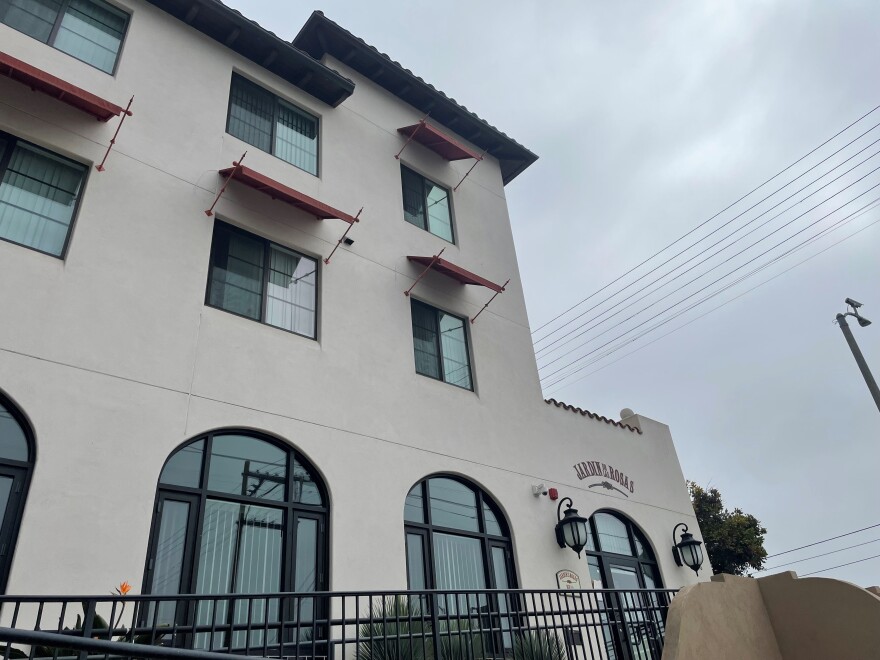The story comes from KCLU’s podcast The One Oh One. You can listen to the full episode here.
The Jardin de las Rosas apartment complex in Santa Barbara was completed a few years ago. It’s got Spanish style red roofs, a learning center, airy corridors and a colorful mural on the playground wall. This, along with its prime downtown-adjacent location, means the complex could be easily mistaken for a pricey rental building... but it’s not. It’s an affordable housing complex.
It’s where I meet Gloria, who we’re only identifying by her first name for privacy reasons. When I ask how long she’s been living here she says two years. Then stops and thinks for a moment and realizes it’s been much longer. More like four years. She can’t believe it. Time passes when you are happy, she explains.
“Oh pues yo llegué porque me mandaron una aplicación donde yo vivía. Me mandaron la aplicación para que fuera aplicar a Carpintería y gracias a Dios fuí una de las afortunadas para... para quedarme aquí con… con ustedes. Aquí con la familia. Tuve buenas personas que me ayudaron para llegar aquí con mis tres nietos. Vivo con tres nietos y estamos aquí, viviendo.”
English translation: “Oh well... I arrived because they sent me an application where I used to live, they sent me the application so I can apply to Carpinteria and thank God I was one of the lucky ones to stay here with… with you. Here with the family. I had good people who helped me to get here with my three grandchildren. I live with three grandchildren and we are here, living.”
She says living at the complex has been a big change for her and her grandchildren, but they are very comfortable here.
We walk up a couple flights of stairs to Gloria’s apartment. She’s taking me on a tour.
Gloria’s apartment is immaculately neat. The lounge has comfy sofas with colorful scatter cushions and a glass cabinet filled with trinkets she’s found at yard sales over the years. On the walls are pictures of Gloria and her family -- of her grandchildren and her mother who she says died about a year ago.
“Murió de 98 años.”
She was 98 years old, Gloria says.

The affordable housing landscape across Santa Barbara County
This home was built and is managed by People’s Self-Help Housing -- a non profit that’s been creating affordable housing across California’s Central Coast for more than 50 years. They’ve created about 3,000 units across the region. Of that, about 1,000 are rental units in Santa Barbara County -- just like Gloria’s.
Ken Trigueiro is the President and CEO of the company.
“It's funny because some people hear, oh, there's a low income housing project coming to my neighborhood. My property's value is going to go down,” said Trigueiro. “But I always take a lot of pride to say, you know what, we'll probably raise the property values in the neighborhood and we do that over and over. So that's just really icing on the cake.”
The company aims to make sure rent is no more than 30 percent of a residents income.
“That's really how we define something as affordable,” said Trigueiro.
He says to build this kind of affordable housing they rely on up to six different sources of funding for each project. But principally, about 60 percent comes from the federal low-income housing tax credit program.
And unsurprisingly, there is high demand for this type of housing right now.
“We've got huge wait lists. So we know that on each property, we've got about 54 or so total, we have over a hundred households on each of those waitlists. And that's an active current number. It's huge,” said Trigueiro.
And it’s a huge problem all across the state -- getting affordable housing built.
Trigueiro says the biggest obstacles they face when trying to create more housing are money and then red tape -- getting through environmental processes, zoning issues, getting local communities on board. It's all a challenge.
But the data they get from the Regional Housing Needs Allocation (RHNA) reports every eight years is very helpful to them, Trigueiro says.
“We look to the RHNA numbers in each jurisdiction to figure out, well, what are those actual numbers to try to help us strategically meet those actual needs. So it's pretty direct and important for us,” said Trigueiro.
The newly approved RHNA report says between 2023 and 2031, Santa Barbara County has to create close to 25,000 units. Of that, the City of Santa Barbara has to create 8,001 units. I asked Trigueiro if these targets are attainable.
“There’s probably sufficient funding to access about half of those RHNA numbers, if you will. We just really struggle to get ahead of it, though. The demand far outstrips the supply,” said Trigueiro.

A short drive across town I meet another person trying to tackle the affordable housing crisis on behalf of the City of Santa Barbara. Rob Fredericks is CEO of the city’s housing authority.
He’s really passionate about housing. He’s been with the authority for 25 years and some have even called him the housing evangelist.
We meet on the corner of Castillo and Carrillo streets just off the 101. Fredericks chose this spot to meet because in almost every direction we look, at this busy intersection, are affordable housing developments.
“We're at the gateway of entering Santa Barbara and people often mistake Casa de Las Fuentes for a bed and breakfast. They'll pull in and say, ‘hey, you got a room to rent for the weekend,’ ” said Fredericks.
Casa de Las Fuentes is a Spanish-style adobe. It was completed in 2002 with a specific workforce population in mind -- low income downtown workers. It’s for workers earning a maximum of $70,000 a year and those without a car are prioritized.
We head inside the complex, pass a beautiful water fountain -- a nod to the name -- and meet Omar Aguilar.
“I moved here May fifth 2021 on my birthday and I... I love it. It's very convenient. It's very close to work. I don't drive so it's wonderful. I get to ride my bikes to work,” said Aguilar.
He says living here has improved his finances and his health.
“I actually am thriving. I’m allowing myself to be more creative, use my extra income on my creative tools,” said Aguilar.
Rent at Casa de Las Fuentes starts at just over $700 a month depending on your unit.
Rob Fredericks, from the city’s housing authority, and I walk down the street to the development next door.
“El Carrillo here, that we built for people moving from homelessness, 62 units on a half acre. And it's beautiful architecture,” said Fredericks.
The rent for the El Carrillo units start at just over $650 a month.
We head inside away from the busy street. This complex was created to be transitional housing for people experiencing homelessness. Units are smaller.
“We want people to move to bigger places once they stabilize. But we've created such community here that a lot of people are original residents here from when we built the development in 2006. We've offered people to move to larger apartments. They like where they live,” said Fredericks.
He is proud of this particular complex because of how much they’ve been able to build in a small space.
“It shows you can build 122 units to the acre and it can be beautiful and the sky won't fall. You'll still have a great development in the city with higher densities,” said Fredericks.

In total the City of Santa Barbara has 72 affordable housing properties totaling almost 1,400 units.
But it’s by far not enough.
The city’s waiting list is currently over 9,000 households long.
The role of RHNA in California’s housing crisis
So I’ve spoken to those who’ve benefited from affordable housing. I’ve spoken to those trying to build affordable housing. Now for the person who’s actually telling everyone how much should be built -- the person who helps come up with the RHNA.
Mike Becker is the director of planning for Santa Barbara County Association of Governments. He defines the RHNA plans this way.
“I think if you had to really boil it down, it's the state's fair share housing law. It's to ensure that no single jurisdiction has to bear a burden or reap the benefits of accommodating housing to satisfy the state's housing needs,” said Becker.
His job is to figure out how much housing is actually needed and then assign that housing fairly to different cities or jurisdictions in Santa Barbara County.
He uses a complicated formula that includes things like the forecasted population and overcrowding and cost burden factors.
Becker creates the plan but it’s up to the cities and jurisdictions to accommodate it.
Here’s Rob Fredericks, Santa Barbara’s housing authority CEO with how well his city does in accommodating RHNA.
“The RHNA numbers really do provide communities with a picture of that need,” said Fredericks. “Now, from a practical sense of meeting those RHNA numbers. It's very impractical. It's a goal. A goal to say we can provide for this much housing in the city. But will we achieve it? Probably not.”
And Mike Becker confirms -- jurisdictions haven’t been achieving this goal.
“Over time we've been delivering about 50 percent of what has been called for,” said Becker.
So, they don’t deliver on the RHNA numbers, and each report shows there’s a huge need. This year a 125 percent increase from the last cycle. It just keeps piling up.
“So we knew it was coming. Nobody in this region doesn't think that we have a housing problem or there is certainly a housing problem. There's a cost burden problem. There's the overcrowding problem. So it was not a surprise,” said Becker.
When the state says failure is no longer an option
And because jurisdictions are not delivering, the state is now attempting to take matters into its own hands by passing all sorts of different housing laws that essentially bypass local jurisdictions.
“The state has said these are ways that we can increase housing production. If it takes away some local control, local control is what created the problem,” said Becker. “So through these laws, it takes away some local control in an effort to to begin to solve it.”
Laws like ones that require local entities to streamline the approval of certain housing projects.
There’s a law which lets almost anyone with a house build an Accessory Dwelling Unit or granny flat.
And there’s a new law that will allow really any homeowner to split their home up to create up to four units.
“And I think ultimately, until housing is delivered based on more where we need, the state’s going to continue to pass these laws,” said Becker.
So here’s where things stand. RHNA is seen as essential to housing planners to quantify the problem -- to understand the housing crisis. But developers, planners and housing officials all say these goals are impossible to achieve. And because of that the state is now saying failure is no longer an option, we’re changing the laws.
A new reality is on the horizon for cities in California just like Santa Barbara. One where if you don’t achieve your RHNA goals, no matter the reason why, the state is saying we’re going around you.
———————————————————————————————————
If you're looking for The One Oh One® Design Collective visit: https://www.theoneohone.com/



